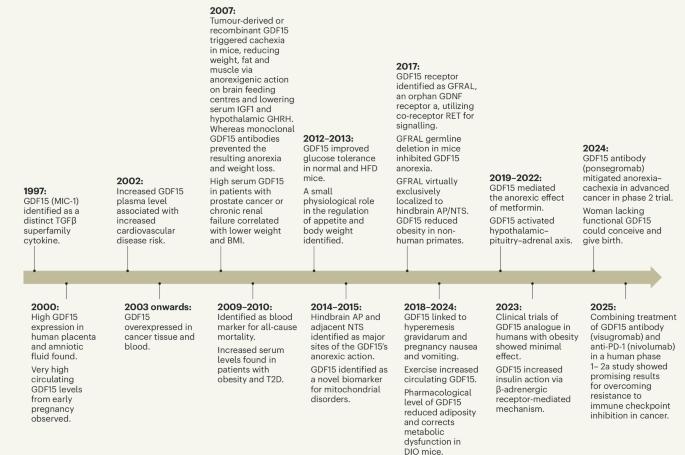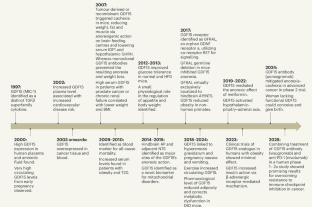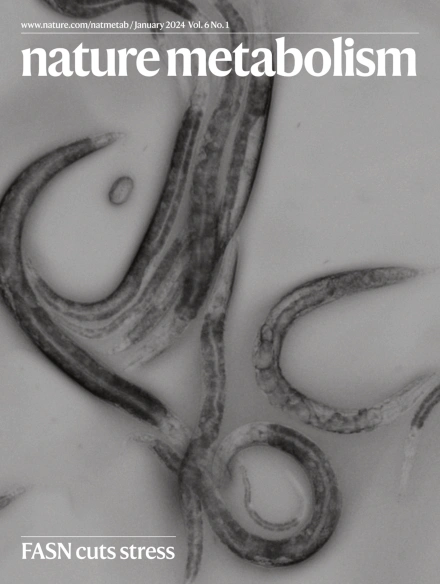Metabolic Messenger: growth differentiation factor 15
IF 20.8
1区 医学
Q1 ENDOCRINOLOGY & METABOLISM
引用次数: 0
Abstract
Growth differentiation factor 15 (GDF15; also known as macrophage-inhibitory cytokine-1) is a stress-responsive cytokine that is overexpressed under a broad range of conditions. It has a role in regulating appetite and body weight and is an aetiological factor in anorexia–cachexia syndromes, as well as nausea and vomiting during pregnancy. Long after its original cloning, its receptor was identified as GFRAL, a distant member of the GDNF receptor family within the TGFβ superfamily, with RET as its co-receptor. Both of these are highly localized to specific hindbrain regions. Although many of GFRAL’s metabolic changes may be linked to its effect on suppressing appetite, recent findings suggest that GDF15 also independently regulates energy expenditure and insulin sensitivity. Here, we review recent literature and provide updates on the current understanding of GDF15 biology and its therapeutic applications in health and metabolic diseases. Breit and Tsai provide a concise overview of the role of GDF15 as a signalling molecule in the context of metabolic health and disease.


代谢信使:生长分化因子15。
生长分化因子15 (Growth differentiation factor 15, GDF15,又称巨噬细胞抑制因子1)是一种应激反应型细胞因子,在多种条件下均可过度表达。它具有调节食欲和体重的作用,是厌食症-恶病质综合征以及怀孕期间恶心和呕吐的病因因素。在最初的克隆后很长一段时间,其受体被鉴定为GFRAL,是TGFβ超家族中GDNF受体家族的远亲成员,RET是其共同受体。两者都高度定位于特定的后脑区域。虽然GFRAL的许多代谢变化可能与其抑制食欲的作用有关,但最近的研究结果表明,GDF15也独立调节能量消耗和胰岛素敏感性。在这里,我们回顾了最近的文献,并提供了GDF15生物学及其在健康和代谢疾病中的治疗应用的最新认识。
本文章由计算机程序翻译,如有差异,请以英文原文为准。
求助全文
约1分钟内获得全文
求助全文
来源期刊

Nature metabolism
ENDOCRINOLOGY & METABOLISM-
CiteScore
27.50
自引率
2.40%
发文量
170
期刊介绍:
Nature Metabolism is a peer-reviewed scientific journal that covers a broad range of topics in metabolism research. It aims to advance the understanding of metabolic and homeostatic processes at a cellular and physiological level. The journal publishes research from various fields, including fundamental cell biology, basic biomedical and translational research, and integrative physiology. It focuses on how cellular metabolism affects cellular function, the physiology and homeostasis of organs and tissues, and the regulation of organismal energy homeostasis. It also investigates the molecular pathophysiology of metabolic diseases such as diabetes and obesity, as well as their treatment. Nature Metabolism follows the standards of other Nature-branded journals, with a dedicated team of professional editors, rigorous peer-review process, high standards of copy-editing and production, swift publication, and editorial independence. The journal has a high impact factor, has a certain influence in the international area, and is deeply concerned and cited by the majority of scholars.
 求助内容:
求助内容: 应助结果提醒方式:
应助结果提醒方式:


